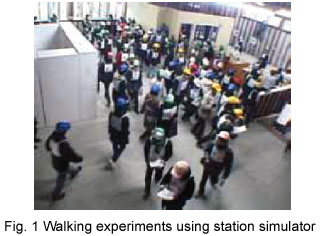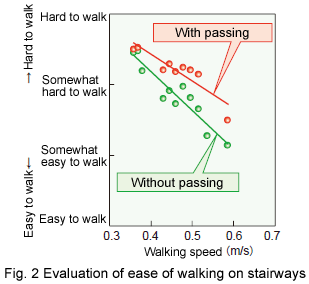Since steady-state congestion is likely to occur at morning and evening rush-hour times in stations, it is necessary to consider the flow of passengers in facility planning. The RTRI has so far ascertained the flow of passengers through whole stations from the design stage with the help of simulation technology, but no technique has been available to evaluate ease of walking from a passenger point of view. Accordingly, the RTRI developed a passenger flow evaluation simulation technique that enables evaluation of ease of walking as experienced by passengers.
The RTRI repeated walking experiments (Fig. 1) using a full-scale simulated station building (referred to as a station simulator) and monitor-based evaluation tests to clarify ease of walking as experienced by passengers as well as the congestion status in concourses (corridors) and on stairways/platforms. It was found that passengers experience walking hindrance enough to slow their walking speed, for example, on crowded stairways (Fig. 2). Using these relationships, the RTRI set up an evaluation equation to establish ease of walking in stations, and developed a passenger flow evaluation simulation that enables calculation using a PC (Fig. 3).
As a result, it is now possible to identify locations where passengers experience walking hindrance in addition to understanding overall passenger flow with the help of the conventional method. This is expected to be useful in facility planning of stations that are easier to walk in and have a lower transfer burden for passengers.
|





